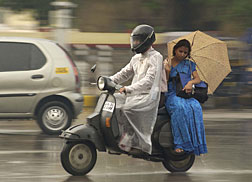- Number 371 |
- September 10, 2012
Pollution weakens monsoon's might

Pollution from vehicles and other fossil fuel
burning in South Asia is a major contributor
to the increased pollution particles, causing
a cooling effect of the surface. The surface
cooling slows atmospheric air circulation,
leading to a reduction in the summer
monsoon rainfall.
Photo courtesy of Arvind Jain.
Motorbike exhausts, coal-fired power plants and other emissions threaten the summer monsoons that are the primary water source for crops and daily living in South Asia, according to research by DOE’s Pacific Northwest National Laboratory. PNNL researchers used the Community Earth System Model with other components to study the effect of human-caused pollution particles on the South Asian summer monsoon. The team ran simulations of the climate in response to changes in particle emissions from pre-industrial to the present day. The team looked at the different responses to pollution's effects on the monsoon. The team found that local aerosols affect rainfall in the initial stages of the monsoon. Aerosols from Eastern Europe, the Middle East, and Africa are more important later in the summer.
The team’s results showed that overall monsoon rainfall was not very sensitive to changes in carbon-containing particles. While there are some atmospheric heating effects from soot particles, ultimately the surface cooling caused by the aerosols from fossil fuel use dominated during the monsoon season to slow down the atmospheric circulation and reduce monsoon rainfall.
One-fifth of the world's population calls South Asia home. The summer monsoon rainfall is a major source of fresh water for their crops and themselves. On a global scale, the monsoons are a major source of energy driving the planet's atmospheric circulation, which can affect the wheat crops in Kansas, as well as the rice fields in India. This research points to pollution's ultimate effects on food and water supplies around the globe.
This research was supported by the U.S. Department of Energy's (DOE's) Office of Science Biological and Environmental Research Climate Change Modeling Program. The researchers used the computing resources at the DOE's National Energy Research Scientific Computing Center.
[Kristin Manke, 509.372.6011,
Kristin.manke@pnnl.gov]
